With us in the crew today are two perpendicular medians, who have something new to say. It’s possible you already knew what they’ll say, but let’s continue all the same. Or, you can jump straight to Example 8.
Join us to welcome perpendicular medians, chief host of today’s post!!!
Median lengths in terms of side lengths
Let ![]() be a triangle whose side lengths are
be a triangle whose side lengths are ![]() . Throughout we’ll adopt the usual convention of denoting the lengths of the medians from vertices
. Throughout we’ll adopt the usual convention of denoting the lengths of the medians from vertices ![]() by
by ![]() , respectively.
, respectively.
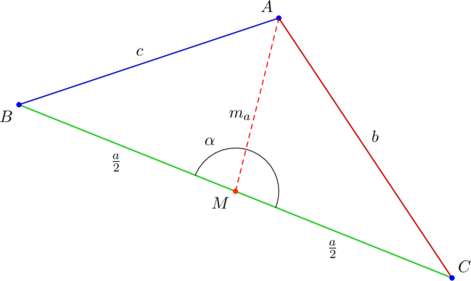
In the above diagram, the median ![]() has length
has length ![]() . Also,
. Also, ![]() , and so
, and so ![]() Notice the side lengths of the triangle as indicated.
Notice the side lengths of the triangle as indicated.
Example 1
PROVE that ![]() and
and ![]()
We only prove the first one, as the other two follow similarly (or by “symmetry”). Let’s use the cosine law to this end.
Applied to ![]() , the cosine law gives, for side
, the cosine law gives, for side ![]() :
:

Similarly, the cosine law applied to ![]() gives, for side
gives, for side ![]() :
:
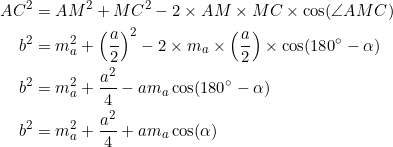
In the last step we used the trigonometric identity ![]() . So we’ve got two equations:
. So we’ve got two equations:
(1) ![]()
(2) ![]()
Adding (1) and (2), the term involving ![]() gets eliminated, leaving behind
gets eliminated, leaving behind
![]()
which can be re-arranged to give ![]() as desired.
as desired.
Example 2
PROVE that ![]()
We simply use the expressions from Example 1: ![]()

For our purposes, the above relationship is very vital.
Example 3
PROVE that ![]()
Again, we use the expressions from Example 1:

Example 4
PROVE that in any triangle, the longer sides have shorter medians.
We use the result of Example 3 above. Suppose that in ![]() we have
we have ![]() . Since
. Since
![]()
the right side is positive. The left side must be positive as well, so ![]() . Since median lengths are positive quantities, we can extract square roots to obtain
. Since median lengths are positive quantities, we can extract square roots to obtain ![]() .
.
If then there’s an ordering ![]() , it will follow that
, it will follow that ![]() , using the transitivity property of inequalities.
, using the transitivity property of inequalities.
Example 5
Find coordinates for the vertices of a ![]() that has the following property:
that has the following property: ![]()
If all we needed were the side lengths, then we could use the equation ![]() and the fact that
and the fact that ![]() to obtain the relation
to obtain the relation ![]() and thereby find suitable side lengths.
and thereby find suitable side lengths.
We’ll instead appeal to triangles whose slopes are in geometric progression, as these provide us with a ready-made solution. Consider ![]() below, with vertices at
below, with vertices at ![]() :
:
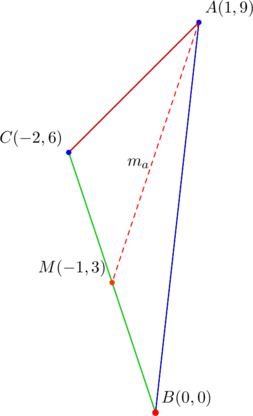
Using the given coordinates, we find, by the distance formula, that:
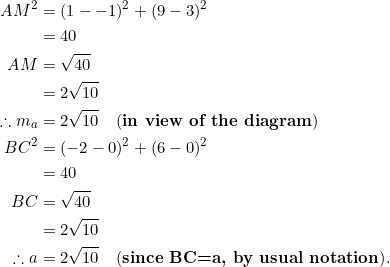
So we obtain for the above triangle,whose vertices are ![]() , that
, that ![]() .
.
Notice that the slopes of the sides of ![]() given above are
given above are ![]() ; so they form a geometric progression with a common ratio of
; so they form a geometric progression with a common ratio of ![]() . There’s something quite interesting that’s hidden there: in any triangle whose sides slopes form a geometric progression with a common ratio of
. There’s something quite interesting that’s hidden there: in any triangle whose sides slopes form a geometric progression with a common ratio of ![]() , there is a vertex
, there is a vertex ![]() such that
such that ![]() .
.
Conditions for perpendicular medians
Example 6
PROVE that medians from vertex ![]() and vertex
and vertex ![]() are perpendicular if, and only if,
are perpendicular if, and only if, ![]() .
.
First suppose that the median ![]() through vertex
through vertex ![]() and the median
and the median ![]() through vertex
through vertex ![]() are perpendicular. Consider the diagram below, where
are perpendicular. Consider the diagram below, where ![]() is the centroid of
is the centroid of ![]() :
:
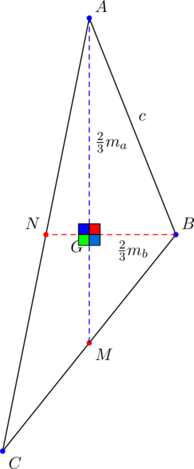
Since the centroid divides the median in the ratio ![]() , we have, in
, we have, in ![]() , that
, that ![]() and
and ![]() . By assumption,
. By assumption, ![]() is a right triangle, so the Pythagorean theorem applied to it gives:
is a right triangle, so the Pythagorean theorem applied to it gives:
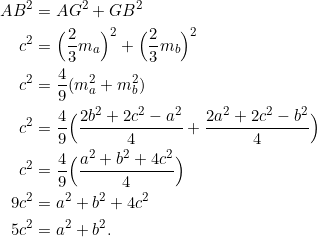
Conversely, if we suppose that the relation ![]() holds, then we need to show that
holds, then we need to show that ![]() . We’ll use the cosine rule to this end.
. We’ll use the cosine rule to this end.
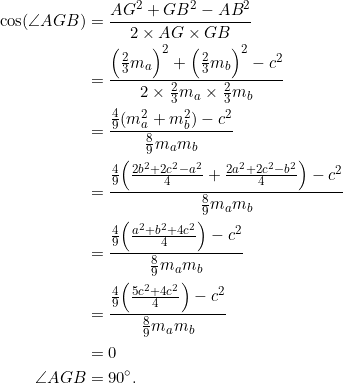
This shows that the medians are perpendicular.
Example 7
PROVE that ![]() if, and only if,
if, and only if, ![]() .
.
We first prove: ![]() .
.
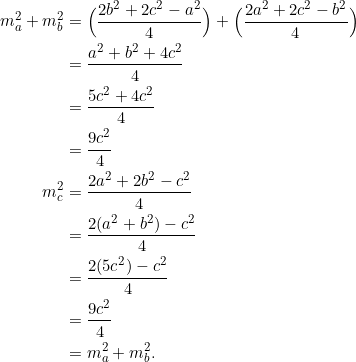
Next, let’s prove ![]() .
.

If all math proofs were this simple!
An easier, equivalent condition
What we’ve featured in our next example is somewhat absent in literature because it’s so miniature. Put differently, it is not found because it is not profound. But it still counts!
Example 8
PROVE that ![]() if, and only if,
if, and only if, ![]() .
.
As you can see, this is extremely easy. To obtain the implication ![]() , begin with the expression for
, begin with the expression for ![]() :
:
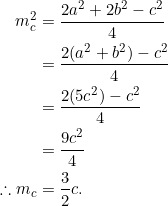
Conversely, if ![]() , then
, then ![]() . So using the expression for
. So using the expression for ![]() again, we have:
again, we have:
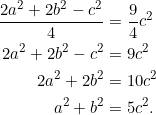
Example 9
For any ![]() with the usual notation, PROVE that each of the following statements implies the others:
with the usual notation, PROVE that each of the following statements implies the others:
- median through vertex
 and median through vertex
and median through vertex  are perpendicular;
are perpendicular;  ;
; ;
;
Actually, this has been done in Example 6, Example 7, and Example 8; we just collect and connect them together here.
Notice that ![]() by virtue of Example 6. Also,
by virtue of Example 6. Also, ![]() is due to Example 7. Then, Example 8 verifies that
is due to Example 7. Then, Example 8 verifies that ![]() .
.
(As a result, we obtain ![]() ,
, ![]() , and
, and ![]() . Each statement therefore implies the others.)
. Each statement therefore implies the others.)
Example 10
Find coordinates for the vertices of a triangle that contains two perpendicular medians.
The easiest way to do this is to start with any three “consecutive” numbers, let’s say ![]() . Then, form three pairs as follows:
. Then, form three pairs as follows: ![]() . That’s it!!! Though with a little caveat: the order is important. You won’t get a triangle with something like
. That’s it!!! Though with a little caveat: the order is important. You won’t get a triangle with something like ![]() .
.
To get a “bigger” triangle, we can space out the numbers, like so: ![]() , then use the three pairs
, then use the three pairs ![]() as our triangle’s vertices, as shown below:
as our triangle’s vertices, as shown below:
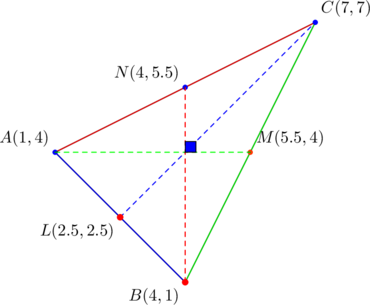
Notice the horizontal median ![]() and the vertical median
and the vertical median ![]() . So these medians are perpendicular. With the given coordinates and the usual notation, let’s write out the three other equivalent conditions:
. So these medians are perpendicular. With the given coordinates and the usual notation, let’s write out the three other equivalent conditions:

In providing examples of perpendicular medians using coordinates, it is always convenient to use the special case in which one median is vertical and the other horizontal. But there are other cases in which the (two perpendicular) medians are neither vertical nor horizontal — for example, the triangle with vertices at ![]() is such. It may happen that we devote another post to those.
is such. It may happen that we devote another post to those.
Takeaway
Of all the three other equivalent conditions for perpendicular medians, it is clear that ![]() is the simplest in “appearance”, but maybe not in application — particularly because it uses the length of one of the medians, so one cannot tell immediately based on the side lengths.
is the simplest in “appearance”, but maybe not in application — particularly because it uses the length of one of the medians, so one cannot tell immediately based on the side lengths.
If all the side lengths ![]() are provided, always use
are provided, always use ![]() in checking for perpendicular medians (assuming you’re concerned with the medians through vertices
in checking for perpendicular medians (assuming you’re concerned with the medians through vertices ![]() and
and ![]() ), but be aware of its equivalent formulations.
), but be aware of its equivalent formulations.
Lastly, to every triangle is a median triangle, whose side lengths are the lengths of the medians of the original triangle. Thus, the median triangle is a right triangle if, and only if, the original triangle contains two perpendicular medians.
Tasks
- Suppose that
 is such that
is such that  and
and  . PROVE that the triangle is equilateral.
. PROVE that the triangle is equilateral.
 As shown in the next exercise, having
As shown in the next exercise, having  alone is not enough to make a triangle equilateral. Also, observe that both
alone is not enough to make a triangle equilateral. Also, observe that both  and
and  together imply that
together imply that  , so requiring all three conditions is asking for too much.
, so requiring all three conditions is asking for too much.
- (This exercise shows that it is possible to have a median whose length is of the form
 , even when the triangle is not equilateral.) To this end, let
, even when the triangle is not equilateral.) To this end, let  ,
,  , and
, and  be the vertices of
be the vertices of  . PROVE that:
. PROVE that:






- the slopes of sides
 form a geometric progression whose common ratio is
form a geometric progression whose common ratio is 
- (Nice Nine)For any triangle
 with the usual notation, PROVE that the following NINE statements are equivalent:
with the usual notation, PROVE that the following NINE statements are equivalent:



 ;
; ;
; ;
; ;
; ;
; .
.
- Suppose that the side lengths
 of a
of a  are related via
are related via  . PROVE that
. PROVE that  .
.
 More generally, we can find constants
More generally, we can find constants  such that
such that  , and
, and  .
. 
- PROVE that there is no
 in which the side lengths
in which the side lengths  satisfy
satisfy  .
.
 Just to buttress the point that the strict inequality in the preceding exercise is crucial. Simply calculate the length
Just to buttress the point that the strict inequality in the preceding exercise is crucial. Simply calculate the length  of the median from vertex
of the median from vertex  to see why the claim is valid.
to see why the claim is valid. 
- Let
 be such that the side lengths
be such that the side lengths  are related via
are related via  . PROVE that:
. PROVE that:
 is either scalene or else equilateral;
is either scalene or else equilateral; or
or  (both for the scalene case);
(both for the scalene case); (and so
(and so  , for the scalene case).
, for the scalene case).
- Let
 be a positive constant. PROVE that
be a positive constant. PROVE that  if, and only if,
if, and only if,  .
.
 In particular, if
In particular, if  , we obtain
, we obtain  , which expresses the popular fact that the length of the median to the hypotenuse of a right triangle is half the length of the hypotenuse. And, only right triangles have this property.
, which expresses the popular fact that the length of the median to the hypotenuse of a right triangle is half the length of the hypotenuse. And, only right triangles have this property.
- Suppose that
 for some constant
for some constant  . What are the admissible values of
. What are the admissible values of  ?
? - PROVE that
 and that
and that  .
. - PROVE that the three medians in a right triangle satisfy
 , where
, where  is the length of the hypotenuse.
is the length of the hypotenuse. - PROVE that
 .
. - PROVE that
 if, and only if,
if, and only if,  .
. - PROVE that an equilateral triangle can never contain two perpendicular medians.
(Not everything goes the way of equilateral triangles after all.) - PROVE that the medians to the “two legs” in a right triangle can never be perpendicular.